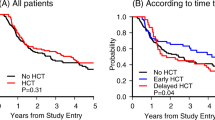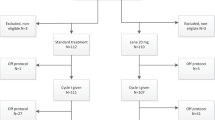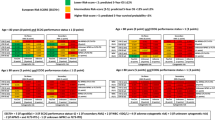Abstract
Acute myeloid leukemia (AML) is primarily a disease of older adults, for whom optimal treatment strategies remain controversial. Because of the concern for therapeutic resistance and, in particular, excessive toxicity or even treatment-related mortality, many older or medically unfit patients do not receive AML-directed therapy. Yet, evidence suggests that outcomes are improved if essentially all of these patients are offered AML therapy, ideally at a specialized cancer center. Medical fitness for tolerating intensive chemotherapy can be estimated relatively accurately with multiparameter assessment tools; this information should serve as basis for the assignment to intensive or non-intensive therapy. Until our accuracy in predicting the success of individual therapies improves, all patients should be considered for participation in a randomized controlled trial. Comparisons between individual trials will be facilitated once standardized, improved response criteria are developed, and standard treatment approaches have been defined against which novel therapies can be tested.
This is a preview of subscription content, access via your institution
Access options
Subscribe to this journal
Receive 12 print issues and online access
$259.00 per year
only $21.58 per issue
Buy this article
- Purchase on Springer Link
- Instant access to full article PDF
Prices may be subject to local taxes which are calculated during checkout


Similar content being viewed by others
References
Alibhai SMH, Leach M, Minden MD, Brandwein J . Outcomes and quality of care in acute myeloid leukemia over 40 years. Cancer 2009; 115: 2903–2911.
Burnett AK . Treatment of acute myeloid leukemia: are we making progress? Hematology Am Soc Hematol Educ Program 2012; 2012: 1–6.
Juliusson G, Lazarevic V, Hörstedt AS, Hagberg O, Höglund M . Acute myeloid leukemia in the real world: why population-based registries are needed. Blood 2012; 119: 3890–3899.
Juliusson G, Antunovic P, Derolf Å, Lehmann S, Möllgård L, Stockelberg D et al. Age and acute myeloid leukemia: real world data on decision to treat and outcomes from the Swedish Acute Leukemia Registry. Blood 2009; 113: 4179–4187.
Oran B, Weisdorf DJ . Survival for older patients with acute myeloid leukemia: a population-based study. Haematologica 2012; 97: 1916–1924.
Meyers J, Yu Y, Kaye JA, Davis KL . Medicare fee-for-service enrollees with primary acute myeloid leukemia: an analysis of treatment patterns, survival, and healthcare resource utilization and costs. Appl Health Econ Health Policy 2013; 11: 275–286.
Howlader N, Noone AM, Krapcho M, Garshell J, Miller D, Altekruse SF et al. SEER Cancer Statistics Review, 1975-2010. National Cancer Institute: Bethesda, MDhttp://seer.cancer.gov/csr/1975_2011/based on November 2013 SEER data submission, posted to the SEER web site, 2014.
Official Website of the U.S. Social Security Administration. Period Life Table, 2009. Available from http://www.ssa.gov/oact/STATS/table4c6.html.
Pollyea DA, Kohrt HE, Medeiros BC . Acute myeloid leukaemia in the elderly: a review. Br J Haematol 2011; 152: 524–542.
Yanada M, Naoe T . Acute myeloid leukemia in older adults. Int J Hematol 2012; 96: 186–193.
Freireich EJ, Gehan EA, Sulman D, Boggs DR, Frei E 3rd . The effect of chemotherapy on acute leukemia in the human. J Chronic Dis 1961; 14: 593–608.
Walter RB, Kantarjian HM, Huang X, Pierce SA, Sun Z, Gundacker HM et al. Effect of complete remission and responses less than complete remission on survival in acute myeloid leukemia: a combined Eastern Cooperative Oncology Group, Southwest Oncology Group, and M. D. Anderson Cancer Center Study. J Clin Oncol 2010; 28: 1766–1771.
Vey N, Coso D, Bardou VJ, Stoppa AM, Braud AC, Bouabdallah R et al. The benefit of induction chemotherapy in patients age > or = 75 years. Cancer 2004; 101: 325–331.
Wetzler M, Mrózek K, Kohlschmidt J, Dombret H, Döhner H, Pilorge S et al. Intensive induction is effective in selected octogenarian acute myeloid leukemia patients: prognostic significance of karyotype and selected molecular markers used in the European LeukemiaNet classification. Haematologica 2014; 99: 308–313.
Burnett AK, Milligan D, Prentice AG, Goldstone AH, McMullin MF, Hills RK et al. A comparison of low-dose cytarabine and hydroxyurea with or without all-trans retinoic acid for acute myeloid leukemia and high-risk myelodysplastic syndrome in patients not considered fit for intensive treatment. Cancer 2007; 109: 1114–1124.
Löwenberg B, Zittoun R, Kerkhofs H, Jehn U, Abels J, Debusscher L et al. On the value of intensive remission-induction chemotherapy in elderly patients of 65+ years with acute myeloid leukemia: a randomized phase III study of the European Organization for Research and Treatment of Cancer Leukemia Group. J Clin Oncol 1989; 7: 1268–1274.
Kahn SB, Begg CB, Mazza JJ, Bennett JM, Bonner H, Glick JH . Full dose versus attenuated dose daunorubicin, cytosine arabinoside, and 6-thioguanine in the treatment of acute nonlymphocytic leukemia in the elderly. J Clin Oncol 1984; 2: 865–870.
Tilly H, Castaigne S, Bordessoule D, Casassus P, Le Prisé PY, Tertian G et al. Low-dose cytarabine versus intensive chemotherapy in the treatment of acute nonlymphocytic leukemia in the elderly. J Clin Oncol 1990; 8: 272–279.
Appelbaum FR, Gundacker H, Head DR, Slovak ML, Willman CL, Godwin JE et al. Age and acute myeloid leukemia. Blood 2006; 107: 3481–3485.
Burnett AK, Russell NH, Hills RK, Hunter AE, Kjeldsen L, Yin J et al. Optimization of chemotherapy for younger patients with acute myeloid leukemia: results of the Medical Research Council AML15 trial. J Clin Oncol 2013; 31: 3360–3368.
Kayser S, Zucknick M, Dohner K, Krauter J, Kohne CH, Horst HA et al. Monosomal karyotype in adult acute myeloid leukemia: prognostic impact and outcome after different treatment strategies. Blood 2012; 119: 551–558.
Kantarjian H, O'Brien S, Cortes J, Giles F, Faderl S, Jabbour E et al. Results of intensive chemotherapy in 998 patients age 65 years or older with acute myeloid leukemia or high-risk myelodysplastic syndrome: predictive prognostic models for outcome. Cancer 2006; 106: 1090–1098.
Giles FJ, Borthakur G, Ravandi F, Faderl S, Verstovsek S, Thomas D et al. The haematopoietic cell transplantation comorbidity index score is predictive of early death and survival in patients over 60 years of age receiving induction therapy for acute myeloid leukaemia. Br J Haematol 2007; 136: 624–627.
Malfuson JV, Etienne A, Turlure P, de Revel T, Thomas X, Contentin N et al. Risk factors and decision criteria for intensive chemotherapy in older patients with acute myeloid leukemia. Haematologica 2008; 93: 1806–1813.
Krug U, Röllig C, Koschmieder A, Heinecke A, Sauerland MC, Schaich M et al. Complete remission and early death after intensive chemotherapy in patients aged 60 years or older with acute myeloid leukaemia: a web-based application for prediction of outcomes. Lancet 2010; 376: 2000–2008.
Kantarjian H, Ravandi F, O'Brien S, Cortes J, Faderl S, Garcia-Manero G et al. Intensive chemotherapy does not benefit most older patients (age 70 years or older) with acute myeloid leukemia. Blood 2010; 116: 4422–4429.
Walter RB, Othus M, Borthakur G, Ravandi F, Cortes JE, Pierce SA et al. Prediction of early death after induction therapy for newly diagnosed acute myeloid leukemia with pretreatment risk scores: a novel paradigm for treatment assignment. J Clin Oncol 2011; 29: 4417–4423.
Savic A, Kvrgic V, Rajic N, Urosevic I, Kovacevic D, Percic I et al. The hematopoietic cell transplantation comorbidity index is a predictor of early death and survival in adult acute myeloid leukemia patients. Leuk Res 2012; 36: 479–482.
Valcárcel D, Montesinos P, Sánchez-Ortega I, Brunet S, Esteve J, Martínez-Cuadrón D et al. A scoring system to predict the risk of death during induction with anthracycline plus cytarabine-based chemotherapy in patients with de novo acute myeloid leukemia. Cancer 2012; 118: 410–417.
Klepin HD, Geiger AM, Tooze JA, Kritchevsky SB, Williamson JD, Pardee TS et al. Geriatric assessment predicts survival for older adults receiving induction chemotherapy for acute myelogenous leukemia. Blood 2013; 121: 4287–4294.
Sherman AE, Motyckova G, Fega KR, Deangelo DJ, Abel GA, Steensma D et al. Geriatric assessment in older patients with acute myeloid leukemia: a retrospective study of associated treatment and outcomes. Leuk Res 2013; 37: 998–1003.
Othus M, Kantarjian H, Petersdorf S, Ravandi F, Godwin J, Cortes J et al. Declining rates of treatment-related mortality in patients with newly diagnosed AML given 'intense' induction regimens: a report from SWOG and MD Anderson. Leukemia 2014; 28: 289–292.
Ferrara F, Schiffer CA . Acute myeloid leukaemia in adults. Lancet 2013; 381: 484–495.
Walter RB, Othus M, Burnett AK, Löwenberg B, Kantarjian HM, Ossenkoppele GJ et al. Resistance prediction in AML: analysis of 4,601 patients from MRC/NCRI, HOVON/SAKK, SWOG, and MD Anderson Cancer Center. Leukemia 2014 (in press).
Sekeres MA, Elson P, Kalaycio ME, Advani AS, Copelan EA, Faderl S et al. Time from diagnosis to treatment initiation predicts survival in younger, but not older, acute myeloid leukemia patients. Blood 2009; 113: 28–36.
Löwenberg B, Ossenkoppele GJ, van Putten W, Schouten HC, Graux C, Ferrant A et al. High-dose daunorubicin in older patients with acute myeloid leukemia. N Engl J Med 2009; 361: 1235–1248.
Hills RK, Castaigne S, Appelbaum FR, Delaunay J, Petersdorf S, Othus M et al. Addition of gemtuzumab ozogamicin to induction chemotherapy in adult patients with acute myeloid leukaemia: a meta-analysis of individual patient data from randomised controlled trials. Lancet Oncol 2014; 15: 986–996.
Sorror ML . Comorbidities and hematopoietic cell transplantation outcomes. Hematology Am Soc Hematol Educ Program 2010; 2010: 237–247.
Gupta V, Tallman MS, Weisdorf DJ . Allogeneic hematopoietic cell transplantation for adults with acute myeloid leukemia: myths, controversies, and unknowns. Blood 2011; 117: 2307–2318.
Chen YB, Aldridge J, Kim HT, Ballen KK, Cutler C, Kao G et al. Reduced-intensity conditioning stem cell transplantation: comparison of double umbilical cord blood and unrelated donor grafts. Biol Blood Marrow Transplant 2012; 18: 805–812.
Peffault de Latour R, Brunstein CG, Porcher R, Chevallier P, Robin M, Warlick E et al. Similar overall survival using sibling, unrelated donor, and cord blood grafts after reduced-intensity conditioning for older patients with acute myelogenous leukemia. Biol Blood Marrow Transplant 2013; 19: 1355–1360.
Kurosawa S, Yamaguchi T, Miyawaki S, Uchida N, Kanamori H, Usuki K et al. A Markov decision analysis of allogeneic hematopoietic cell transplantation versus chemotherapy in patients with acute myeloid leukemia in first remission. Blood 2011; 117: 2113–2120.
Farag SS, Maharry K, Zhang M-J, Pérez WS, George SL, Mrózek et al. Comparison of reduced-intensity hematopoietic cell transplantation with chemotherapy in patients age 60–70 years with acute myelogenous leukemia in first remission. Biol Blood Marrow Transplant 2011; 17: 1796–1803.
Fenaux P, Mufti GJ, Hellstrom-Lindberg E, Santini V, Gattermann N, Germing U et al. Azacitidine prolongs overall survival compared with conventional care regimens in elderly patients with low bone marrow blast count acute myeloid leukemia. J Clin Oncol 2010; 28: 562–569.
Kantarjian HM, Thomas XG, Dmoszynska A, Wierzbowska A, Mazur G, Mayer J et al. Multicenter, randomized, open-label, phase III trial of decitabine versus patient choice, with physician advice, of either supportive care or low-dose cytarabine for the treatment of older patients with newly diagnosed acute myeloid leukemia. J Clin Oncol 2012; 30: 2670–2677.
Blum W, Garzon R, Klisovic RB, Schwind S, Walker A, Geyer S et al. Clinical response and miR-29b predictive significance in older AML patients treated with a 10-day schedule of decitabine. Proc Natl Acad Sci U S A 2010; 107: 7473–7478.
Estey EH . Epigenetics in clinical practice: the examples of azacitidine and decitabine in myelodysplasia and acute myeloid leukemia. Leukemia 2013; 27: 1803–1812.
Walter RB, Appelbaum FR, Tallman MS, Weiss NS, Larson RA, Estey EH . Shortcomings in the clinical evaluation of new drugs: acute myeloid leukemia as paradigm. Blood 2010; 116: 2420–2428.
Mengis C, Aebi S, Tobler A, Dähler W, Fey MF . Assessment of differences in patient populations selected for excluded from participation in clinical phase III acute myelogenous leukemia trials. J Clin Oncol 2003; 21: 3933–3939.
Burnett AK, Hills RK, Hunter AE, Milligan D, Kell WJ, Wheatley K et al. The addition of gemtuzumab ozogamicin to low-dose Ara-C improves remission rate but does not significantly prolong survival in older patients with acute myeloid leukaemia: results from the LRF AML14 and NCRI AML16 pick-a-winner comparison. Leukemia 2013; 27: 75–81.
Burnett AK, Russell NH, Hunter AE, Milligan D, Knapper S, Wheatley K et al. Clofarabine doubles the response rate in older patients with acute myeloid leukemia but does not improve survival. Blood 2013; 122: 1384–1394.
Mell LK, Jeong JH . Pitfalls of using composite primary end points in the presence of competing risks. J Clin Oncol 2010; 28: 4297–4299.
Redaelli A, Botteman MF, Stephens JM, Brandt S, Pashos CL . Economic burden of acute myeloid leukemia: a literature review. Cancer Treat Rev 2004; 30: 237–247.
Efficace F, Kemmler G, Vignetti M, Mandelli F, Molica S, Holzner B . Health-related quality of life assessment and reported outcomes in leukaemia randomised controlled trials—a systematic review to evaluate the added value in supporting clinical decision making. Eur J Cancer 2008; 44: 1497–1506.
Appelbaum FR, Rosenblum D, Arceci RJ, Carroll WL, Breitfeld PP, Forman SJ et al. End points to establish the efficacy of new agents in the treatment of acute leukemia. Blood 2007; 109: 1810–1816.
Othus M, Appelbaum FR, Petersdorf S, Erba HP, Estey EH . Evaluation of which patients get a second course of 3+7 on cooperative group trials for newly diagnosed acute myeloid leukemia: a report from SWOG [abstract]. Blood 2013; 122: 3925.
Estey E . Do commonly used clinical trial designs reflect clinical reality? Haematologica 2009; 94: 1435–1439.
Acknowledgements
Research reported in this publication was supported by a grant from the National Cancer Institute/National Institutes of Health (NCI/NIH; R21-CA182010 to R.B.W.). R.B.W. is a Leukemia & Lymphoma Society Scholar in Clinical Research.
Author information
Authors and Affiliations
Corresponding author
Ethics declarations
Competing interests
The authors declare no conflict of interest.
Rights and permissions
About this article
Cite this article
Walter, R., Estey, E. Management of older or unfit patients with acute myeloid leukemia. Leukemia 29, 770–775 (2015). https://doi.org/10.1038/leu.2014.216
Received:
Revised:
Accepted:
Published:
Issue Date:
DOI: https://doi.org/10.1038/leu.2014.216
This article is cited by
-
G-CSF upregulates the expression of aquaporin-9 through CEBPB to enhance the cytotoxic activity of arsenic trioxide to acute myeloid leukemia cells
Cancer Cell International (2022)
-
Time-dependent treatment effects of metronomic chemotherapy in unfit AML patients: a secondary analysis of a randomised controlled trial
BMC Research Notes (2021)
-
The implications of IDH mutations for cancer development and therapy
Nature Reviews Clinical Oncology (2021)
-
The emerging roles of N6-methyladenosine RNA methylation in human cancers
Biomarker Research (2020)
-
Azacytidine in Newly Diagnosed FLT3-ITD-Positive Acute Myeloid Leukemia Presenting with Pneumonia: A Case Series
Indian Journal of Hematology and Blood Transfusion (2020)



